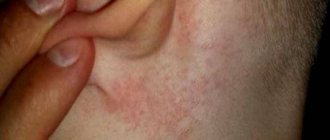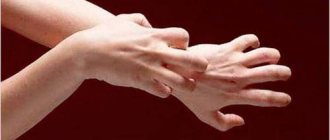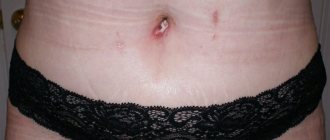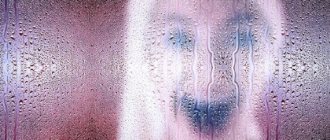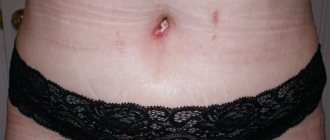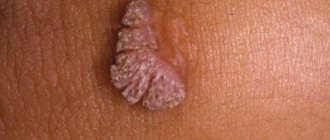Itching below the knees not only causes discomfort, forces you to restrain yourself from scratching in crowded places, and prevents you from wearing your favorite clothes in the summer, but also indicates a possible ongoing disease of the internal organs. Therefore, when the legs below the knees itch, the causes of this condition must be established without fail. In this article we will look at the factors that provoke the occurrence of this symptom, as well as how to treat itching.
Itching below the knees: what could be the cause?
If your legs itch below the knees, then the reasons may be “superficial”, not indicating the need for concern, which can be easily eliminated on your own, or requiring a competent examination and timely treatment. It is much easier to cope with itching that is caused by external factors.
External reasons
- Mechanical damage . Itchy skin on the legs below the knees can appear after improperly performed hair removal or as an allergy to shaving products. Movements should be carried out in the direction of hair growth. Otherwise, the cuticle is damaged, new hairs do not break out, but grow into the epidermis, causing severe itching.
- Dry skin . Skin becomes dry when it loses moisture. This can be caused by frequent showering with soap, going to the pool, or not drinking enough water. The skin begins to peel and itch.
- A tan . The epidermis is damaged during tanning in the sun or in a solarium. As a result, the top layers peel off, causing discomfort. This means that sunbathing was not done correctly.
- Insect bites . Insect bites most often affect the legs from the knee to the foot. Midges lubricate the epidermis with saliva, which is an analgesic, and then bite off part of the skin. As a result, the bite site thickens, redness, swelling and severe itching appear. Your feet are constantly itching, but you should not scratch them to avoid infection.
Diseases accompanied by itching of the legs below the knees
If your legs itch from the feet to the knees, this may be a signal of an ongoing illness. There are many reasons, and the disease can be identified by its characteristic symptoms.
| Cause | Symptoms |
| Vascular pathology | Varicose veins are more common in middle-aged and older people. Veins and nodules are visible from the knees to the ankles, swelling and fatigue of the legs are observed. With light pressure, pain is felt and the skin on the legs itches. Symptoms intensify after long walking or physical fatigue. |
| Allergy | It manifests itself as a rash of small red pimples or redness at the site of contact with the allergen. The skin on the legs rarely reacts to food. Allergies can be caused by residual detergents on clothes and synthetic materials. |
| Dermatitis | Manifests itself in the form of an allergic reaction to familiar foods and skin care cosmetics. The leg itches below the knee on the front side of the shin. Pink spots appear and the skin feels tight. Exacerbation is provoked by stress, lack of sleep, consumption of sweets, spicy foods, and alcohol. |
| Psoriasis | At an early stage, peeling and itching are noticeable in the ankle area. Then papules and plaques appear, having a convex shape, and the joints hurt. Itching intensifies with nervous experiences, drinking alcohol and fatty foods. |
| Eczema | Severe redness and blisters appear on the legs, which then burst, giving way to suppuration. The legs below the knees are very itchy, the itching bothers me during sleep and rest. The temperature in the affected area rises. |
| Hives | It appears as a small red rash like after a nettle burn. Causes severe itching and burning. Possible as an allergic reaction to certain foods, cosmetics, and medications. |
| Scabies | Itching in the legs below the knee and throughout the body is caused by a microscopic mite, which is transmitted through contact with a sick person. You want to scratch itchy areas more after taking a shower, bath, or while sleeping. Most often, outbreaks of the disease are observed in the second half of the calendar year. |
| Worm infestations | Everyone is at risk; many people get sick, but don’t even know it. Symptoms include itchy feet, fatigue, irritability, drowsiness, and disturbances in the gastrointestinal tract. It is not always possible to determine the presence of worms, because it is necessary to take tests at least 10 times in order to confidently make a diagnosis. |
| Neurological disorders (neuropathy, osteochondrosis, multiple sclerosis, tumors) | Muscle wasting appears, sleep disturbances appear, limbs itch, fatigue quickly sets in, and joints ache. |
| Pathology of the kidneys and liver | With kidney failure, the legs become swollen and itchy. This is due to a decrease in excretory capacity and the release of salt through the skin. In case of liver diseases, in addition to itching of the legs, one feels dry and bitter in the mouth, and spider veins appear throughout the body. |
| Blood diseases (polycythemia, lymphoma) | With high bone marrow activity, there is an increase in red blood cells, white blood cells and platelets. As a result, blood flow and the supply of cells with oxygen and necessary elements are disrupted. This is expressed by itching of the legs from the knees to the feet, pain in the calf muscles. |
| Endocrine diseases (diabetes mellitus, hyperthyroidism) | Dry skin appears, a crawling sensation occurs, and wounds of various types take a long time to heal. There may be severe itching and pain. Due to thinning and dry skin, it can be easily injured. |
| Psychosomatic disorders (depression, anorexia) | Itching and heaviness in the limbs, fever, headaches, fever, nausea. |
| Restless legs syndrome (RLS) | There is an itching sensation and a desire to move the legs at rest. A neurological disease is more often diagnosed in women, but also occurs in men. The cause may be a lack of calcium and magnesium. Pregnant women are a special risk group. Mild periodic itching throughout the body at this time is normal and is associated with skin stretching and hormonal changes. But if the itching becomes severe, it may indicate restless leg syndrome, diabetes, or varicose veins. |
| Fungal infections | Most often, the fungus affects the feet, but can spread to the lower leg and calves. The skin becomes pale in the affected areas, and an unpleasant putrid odor appears. If left untreated, large areas may be affected. The fungus gets on the skin through a wound, mechanical damage, or sharing hygiene items with a sick person. |
Read also: Skin flakes and itches on the body: causes of itching, dryness, how to treat
General information
Doctors say that spots on the inner thighs usually occur in male patients aged 25-40 years.
Less commonly, problems with inflammation of the hips are observed in women in the age group of 30-40 years. Such spots can have different characteristic colors, different shapes and sizes. The inflammation may become bright red, dark or brown.
The size of the spot itself can reach a diameter of several centimeters, and even cover a large circumference of the inner thigh (from 10 cm and above).
But what to do if a skin disease manifests itself quickly and develops into large areas of irritation? Experts say that you should pay attention to the symptoms that are accompanied by the appearance of spots. Indeed, thanks to the characteristic signs, doctors can identify the cause of inflammation and the manifestation of skin problems.
Thus, the development of fungal diseases on the human body is characterized by signs in the form of redness, wetting of the wounds, peeling and itching. When an allergy occurs, the source of inflammation usually appears very spontaneously and quickly fades away. Chronic dermatoses are characterized by seasonal manifestations.
Itchy feet below the knees in winter
Sometimes the pathology is seasonal, and the legs below the knees itch only in winter. To understand what to do, you need to identify why this is happening.
- Allergy to the material from which winter clothing is made. Warm clothes that keep you warm in cold weather are mostly synthetic. Your feet may not be cold, but still get irritated from contact. Or there may be a double reaction: itching from hypothermia and friction with synthetics.
- Cold dermatitis. An inflammatory reaction to cold, which is expressed by red itchy spots and cracks in the skin. It appears in most cases on open areas of the body, as well as on the knees and below.
- Allergy to cold. In the cold, histamine is released, causing the calves to itch.
- Exacerbation of chronic dermatological diseases. In winter, chronic diseases can worsen, and other than the usual course of treatment, no measures will help.
How and how to treat itchy legs below the knees
Various causes can cause itching of the legs below the knees; treatment and recovery depend entirely on a correct and timely diagnosis. Only the attending physician should be trusted to prescribe a course of therapy.
| Causes | Course of treatment (medicines, dosage, duration of use) |
| Dry skin | To get rid of the disease you need to drink at least 1.5 liters of water per day. Regular or mineral without gases, green or white tea without sugar will do. When taking a shower, you need to choose moisturizing cosmetics (milk, gel). For excessive dryness, nourish the skin with natural oils. |
| A tan | To avoid discomfort, you should apply sunscreen before sunbathing, and then smear your skin with after-sun lotion. With proper care, the epidermis will be protected from ultraviolet rays, which dry out and burn it, and will also be well hydrated. Also treat the affected area with drugs: Panthenol, Bepanten 3 times a day. |
| Insect bites | Treat wounds with boric alcohol, brilliant green, furatsilin solution, menthol ointment 2 times a day until the itching goes away and the swelling subsides. Alcohol tincture, Menovazin or Menovazan cream help well. They need to be applied 2-3 times a day until the problem is eliminated. |
| Allergy | To block the release of histamine, Ketotifen is prescribed 1 tablet 2 times a day. It is also recommended to treat the affected area with antihistamines. Antihistamine tablets Cetrin and Fenistil gel help well. |
| Skin diseases | The correct course can only be prescribed by the attending physician after a complete examination. For psoriasis, atopic dermatitis, and eczema, Skin-cap aerosol is used. For complex diseases, hormonal drugs can be prescribed: Prednisolone, Dexamethasone. You cannot take them for longer than 10 days. |
| Psychosomatic disorders | To eliminate itching, you need to correctly determine the cause. For disorders of this nature, only a psychotherapist can make a correct diagnosis. Self-medication can cause the problem to get worse. The complex prescribes sedatives, physiotherapy, and electrosleep. |
| Parasites | The following drugs help against helminths: Mebendazole, Pyrantel, Deparasite. Reception course: 30 days. Spregal aerosol helps well against scabies. At the initial stage, the disease goes away with one application. Benzyl benzonate emulsion – for the treatment of head lice and scabies. Apply 2 times every 2 days. Safe for children. |
| Liver | The doctor prescribes Essentiale 3 times a day for a month, Lipoic acid in the same course. |
| Phlebeurysm | Troxevasin, Detralex. Doctors also recommend using ointments and gels: Venoruton, Venitan, Ginkor Gel, Lyoton. |
| Fungus | Clotrimazole cream is applied to the affected areas of the skin in a thin layer 2-3 times a day for 2-4 weeks. |
Read also: Why do the palms of your hands itch: causes of itching, how to treat
In addition to taking medications, simple rules can help eliminate symptoms and reduce itching:
- Apply a cold compress to the area of skin that itches.
- Don't be nervous, get a good night's sleep. If this doesn’t work, you need to take sedatives and drink tea with mint and lemon balm.
- Take vitamins, especially groups B and C. You can prepare a rosehip decoction and drink it instead of tea. Eat lemons or squeeze juice into drinks.
- Use natural cosmetics. Until the itching goes away completely, you can buy a children's care series.
- Wear comfortable clothes made from natural fabrics.
- Drink more water.
- Stick to a simple diet, excluding spicy seasonings, preserves, sweets, and alcohol.
Diagnosis and treatment of spots on the thighs
Patients with skin lesions on the inner thighs often do not know how to get rid of reddened and darkened spots on the body.
If such formations appear on the skin, then patients should pay special attention to the characteristic symptoms in the damaged area. If burning and flaky growths occur, it is most likely necessary to treat a fungal infection on the skin. If water blisters and swelling appear on the upper part of the epidermis, then specialists can diagnose the manifestation of allergic reactions in the patient. If the inflammatory spots do not go away within several days, then we can talk about symptoms of dermatitis. An experienced dermatologist will help you deal with this problem.
When fungal skin diseases athlete's foot and rubromycosis occur, doctors prescribe the use of external medications:
- Ketoconazole;
- Terbinafine;
- Naftifina;
- Bifonazole;
- Oxiconazole.
You can try to get rid of such a simple non-infectious disease as psoriasis on your own, using various advertised drugs. These can be either biological products and vitamins, or various ointments and hormonal agents:
- Stelara;
- Remicade;
- Etretinate;
- Neotigazon;
- Daivonex;
- Belosalik;
- Akriderm SK.
However, it is most correct to seek help from experienced specialists in the field of dermatology when areas of irritation and characteristic spots occur. Doctors will prescribe an effective course of treatment, prescribing all the necessary medications and techniques. For example, to combat psoriasis, it is often recommended to take baths with sea salt collected from the shores of the Dead Sea.
Pityriasis rosea goes away without special treatment procedures within four to six weeks. Also, after a while, the symptoms of contact dermatitis disappear.
At the same time, with the development of multi-colored lichen on the skin, doctors prescribe antifungal agents for external use:
- Clotrimazole;
- Salicylic acid;
- Rubbing the inflammation with boric alcohol;
- The drug Nizoral.
How to get rid of itching below the knees using traditional methods
In addition to the main treatment, you can make home remedies using traditional recipes.
- Mix St. John's wort, chamomile and mint in equal quantities, steam with boiling water and add to the bath. Carry out the procedure daily.
- Lubricate the affected area with castor or sea buckthorn oil
- Make apple cider vinegar lotions 3 times a day.
- Boil the dill seeds. After cooling, take the decoction 3 times a day, half a glass.
It is important to first establish why your legs below the knees itch, and then decide how to cure the disease. You cannot prescribe medications on your own.


